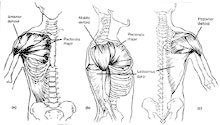The shoulder is a very important part of the body. Not only does the shoulder make your upper body appear to be wider (especially good for bodybuilders), but if not trained correctly, it could give you problems for the rest of your life. The key to building massive shoulders is to understand how the shoulder works and how to keep it healthy.

Anatomy
Let's first take a look at the anatomy of the shoulder before we get into the tips and workouts:
The shoulder is the most movable joint in the body but is very unstable. The shoulder itself is a ball and socket joint. The ball of the shoulder is the head of the humerus. The socket portion of the shoulder is called the glenoid (where arthritis in the shoulder forms).
On top of the ball and socket is a process called the acromion (where bone spurs can form). Next to the acromion is the acromioclavicular joint, also called the AC Joint (this is a common place for shoulder separations). This ball and socket joint allows for the most range of motion out of all the joints in the body.
By using a goniometer, a normal range of motion has been set. Your shoulder can abduct 150 degrees; you have forward flexion of 180 degrees, extension of the shoulder at 45 degrees, external rotation of the shoulder at 90 degrees, and internal rotation of the shoulder at 90 degrees.
 |
What Is A Goniometer? A calibrated device for measuring the arc or range of mobility of a joint. Also called an arthrometer. |
 |
 |
||
 Rotator Cuff:
Rotator Cuff:
Another key component of the shoulder is the rotator cuff. This is a place for common injuries to take place due to overuse or underuse. The rotator cuff is made up of four muscles; the teres minor, infraspinatus, supraspinatus, and subscapularis. These four muscles are what aid in all overhead and rotational movements at the shoulder.
| RELATED ARTICLE | ||
|

Rotator Cuff Injuries
Because your rotator cuff does not consist of large, strong muscles, many injuries occur. Some common injuries are instability, dislocation, subluxation, AC separation, and clavicle fractures. Your shoulder is very susceptible to injuries especially for people who play sports that have overhead motions such as baseball, softball, swimming, and tennis just to name a few.
The most common injury with overhead sports is tendonitis. Another injury that can occur in the shoulder is when the space between the rotator cuff and the bone above is narrowed and the rotator cuff tendons and overlying bursa can get squeezed which can cause bursitis and tendonitis as well. Worst case scenario of rotator cuff injuries would be the partial and full tears. These types of injuries normally require surgery.
 Rotator Cuff Strengthening Exercises:
Rotator Cuff Strengthening Exercises:
There are many types of exercises specifically used to strengthen the rotator cuff. These exercises are to be done with a light weight. Using a weight that is too heavy will surely make the problem worse so to prevent this many therapy clinics are using bands or tubing to rehab and strengthen the rotator cuff.
Some of the most common exercises that can be done for the rotator cuff would be external rotation, internal rotation, abduction, and extension. As always, if you feel you have injured your rotator cuff, get it checked by your physician before you do anything else which could aggravate the injury even more.
 Exercises To Avoid Rotator Cuff Injuries:
Exercises To Avoid Rotator Cuff Injuries:
Some exercises to avoid due to the stress they put on the rotator cuff would be the behind the neck pulldown. This movement puts great stress on the rotator cuff and can easily cause an injury due to the external rotation of the exercise. If you are going to be doing pulldowns or pull-ups, the safest way to do them would be to bring the bar to your chest.
Another exercise to avoid would be the behind the neck shoulder press. This again puts a lot of stress on the rotator cuff and is a main culprit of rotator cuff injuries in the gym.
To minimize injuries your best bet is to use a weight that you can control throughout the movement. If you have to throw the weight around or can only do partial reps, the weight is too heavy and you are putting undue stress on your shoulder. Lighten the weight and make sure you can go through a full range of motion with correct form/technique.
It is also a good idea even before you have a symptom of a shoulder injury to start strengthening your rotator cuff with some band work during your shoulder routine. This will help prevent the problem before an injury can arise.

Deltoids
When you think about your shoulder, what comes to mind are the deltoid muscles. You have a front deltoid, middle deltoid, and a rear deltoid to keep things simple.
 Common Shoulder Exercises:
Common Shoulder Exercises:
*Any exercise that you feel pain or clicking should be stopped immediately.
Here is a great link to shoulder exercises and how they should be done correctly with pictures, video, and written out directions: Click.

From The Forum
Here are some tips and workouts from some of the members of the Bodybuilding.com Forum:

 Braindx:
Braindx:
Some of the major hindrance to shoulder gains come from:
-
Rotator cuff weakness. A lot of the pushing exercises like benching focus mainly on the internal rotation of the rotator cuff. Doing rotator cuff exercises especially for external rotation can help rectify the imbalance. I know several people for which this is the case.
Strengthening their rotator cuffs has helped the stability of the shoulders and let them become stronger once they started up shoulder training again.
-
Weak posterior deltoids. Your body won't let your muscles become too imbalanced. My shoulder progress plateaued until I started hitting my posterior deltoids harder, and now the strength of my anterior and medial deltoids are going up with my increases in posterior deltoid strength. With these increases in strength come increases in mass.

 rawforce:
rawforce:
Try front raises with the EZ bar, try different grips, do 2 sets shoulder wide-grip then 2 with the inside grip, (don't swing your body 2 much while doing it), also to add some more intensity you could do db lateral raises sitting on bench (upright it first), then rest your back on the bench so that you don't swing when you lift.
So try overhead db presses- 4 sets
EZ bar front raises - 4 sets
Lateral raises - 3 sets
Shrugs - 3 to 4 sets
 Click Here For A Printable Log Of rawforce's Shoulder Routine.
Click Here For A Printable Log Of rawforce's Shoulder Routine.

 JadeDragon:
JadeDragon:
I do 12 sets when I work shoulders. 4 for anterior, 4 middle delts, 4 rear delts.

 FarEastBeast:
FarEastBeast:
Delts are a surprisingly difficult muscle group for some people to get a feel for. I know - I'm one of them! I went through probably every problem you've described above. For awhile I even listened to some e-trainer who said you don't need direct shoulder work - big mistake.
Anyway, here's my advice: go back to your low weights and make sure your form is perfect on dumbbell lateral raises. Keep repping and you'll know your form is good when both shoulders are burning. A lot of people say burn doesn't mean anything, fine, but it does mean you're working the target muscle - you can actually feel it burning!
Do enough reps and you'll probably even be sore the next day. Then you know you got it. OK, once you have that down, you can use those to pre-exhaust your delts for the pressing movements. What this does is two-fold: it will maximize shoulder work relative to triceps, and, it will allow you to use lighter loads (and thus better form) but still get a good workout.
I suggest three sets each of the following:
Dumbbell laterals
Front raises OR db rear laterals (depending on which is weaker - if both are weak, rotate from workout to workout)
Arnold presses
Military presses
 Click Here For A Printable Log Of FarEastBeast's Shoulder Routine.
Click Here For A Printable Log Of FarEastBeast's Shoulder Routine.
If you're still having a problem handling heavy enough loads on the presses with good form, machines can help, but don't rely on them, get back to free weights and then use machines once-in-a-while for variety. Also, once you get to "feeling" your delts, you can ditch the pre-exhaust and start with heavy presses. Good luck.

 AbMasterD:
AbMasterD:
For both medial and frontal delts, arnold presses work wonders for mass and definition.

 Nainoa:
Nainoa:
I wouldn't advise doing anything that goes "Behind the Neck" in a pressing motion negative... If you lack sufficient shoulder flexibility there are unhealthy stresses put onto certain elements in your shoulder, such as the AC ligament...
For Military Press lower to a range of the bar at a level somewhere between nose and chin level, before pressing back up.

 DiamondDelts:
DiamondDelts:
Doing your laterals on a incline will give your medial delts continuous tension throughout the entire range of motion. Which is great for growth in my book. Standing laterals offer almost no resistance at the beginning of the exercise. While lying laterals offer little resistance at the top of the movement. Incline is a great hybrid between both without their weak points.


 Back
Back


